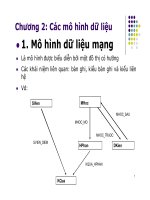Bài giảng Thiết kế và quản trị cơ sở dữ liệu - Chương 5: Concurrency
Bạn đang xem bản rút gọn của tài liệu. Xem và tải ngay bản đầy đủ của tài liệu tại đây (254.34 KB, 7 trang )
<span class='text_page_counter'>(1)</span><div class='page_container' data-page=1>
Concurrency
Vu Tuyet Trinh
Department of Information Systems, Faculty of Information Technology
Hanoi University of Technology
2
Example
read(A)
If A > 500 then
B:=B+500
A:=A-500
<b>Account A </b> <b>Account B </b>
<b>Crash </b> <b>What happen </b>
<b>??? </b>
</div>
<span class='text_page_counter'>(2)</span><div class='page_container' data-page=2>
3
Transaction
A sequence of read and write operations on data items
that logically functions as one unit of work
Assuring data integrity and correction
ACID Properties
<b>A</b>tomicity
<b>C</b>onsistency
<b>I</b>solation
<b>D</b>urability
Concurrency
Control
Recovery
Automicity
guarantee that either all of the tasks of a transaction are
performed or none of them are
Example
T: Read(A,t1);
If t1 > 500 {
Read(B,t2);
t2:=t2+500;
Write(B,t2);
t1:=t1-500;
Write(A,t1);
}
</div>
<span class='text_page_counter'>(3)</span><div class='page_container' data-page=3>
5
Consistency
ensures that the DB remains in a consistent
state before the start of the transaction and after
the transaction is over
Example
T: Read(A,t1);
If t1 > 500 {
Read(B,t2);
t2:=t2+500;
Write(B,t2);
t1:=t1-500;
Write(A,t1);
}
A+B = C
A+B = C
6
Isolation
ability of the application to make operations in a
transaction appear isolated from all other operations.
Example A= 5000, B= 3000
T: Read(A,t1);
If t1 > 500 {
Read(B,t2);
t2:=t2+500;
Write(B,t2);
t1:=t1-500;
Write(A,t1);
}
</div>
<span class='text_page_counter'>(4)</span><div class='page_container' data-page=4>
7
Durability
guarantee that once the user has been notified of
success, the transaction will persist, and not be undone
Ví dụ:A= 5000, B= 3000
T: Read(A,t1);
If t1 > 500 {
Read(B,t2);
t2:=t2+500;
Write(B,t2);
t1:=t1-500;
Write(A,t1);
}
A= 4500, B=3500
crash
</div>
<span class='text_page_counter'>(5)</span><div class='page_container' data-page=5>
9
Transaction Management Interfaces
Begin Trans
Commit ()
Abort()
Savepoint Save()
Rollback (savepoint)
(savepoint = 0 ==> Abort)
10
Concurrency Control
Objective:
ensures that database transactions are performed concurrently
without the concurrency violating the data integrity
guarantees that no effect of committed transactions is lost, and
no effect of aborted (rolled back) transactions remains in the
related database.
Example
T0: read(A); T1: read(A);
</div>
<span class='text_page_counter'>(6)</span><div class='page_container' data-page=6>
11
Scheduling
<b>(1) </b> <b>(2) </b> <b>(3) </b>
Serializability
A schedule of a set of transactions is a linear ordering
of their actions
e.g. for the simultaneous deposits example:
R1(X) R2(X) W1(X) W2(X)
A serial schedule is one in which all the steps of each
transaction occur consecutively
</div>
<span class='text_page_counter'>(7)</span><div class='page_container' data-page=7>
13
Lock
Definition
a synchronization mechanism for enforcing limits on
access to DB in concurrent way.
one way of enforcing concurrency control policies
Lock types
Shared lock (LS) readable but can not write
Exclusive lock (LX): read and write
UN(D): unlock
Compatibility
LS LXLS true false
LX false false
14
Example
T0: LX(A); T1: LX(A);
read(A); read(A);
A := A -50; temp := A *0.1;
write(A); A := A -temp;
LX(B); write(A)
read(B); LX(B);
B := B + 50; read(B);
write(B); B:=B+temp;
UN(A); write(B);
UN(B); UN(A);
</div>
<!--links-->









